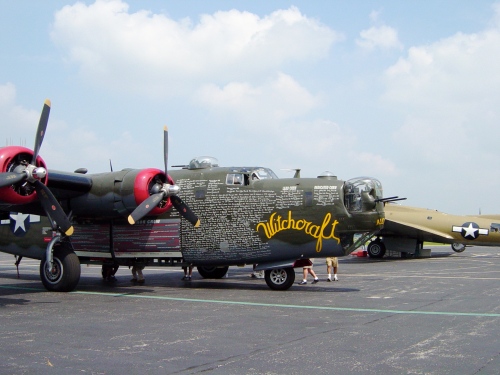 I am a captive to the evocative and iconic aspects of vintage military aircraft, particularly those from the mid-1930s through the mid 1950s, the period from the Boeing P-26 “Peashooter” through the F-86 “Sabrejet.”
I am a captive to the evocative and iconic aspects of vintage military aircraft, particularly those from the mid-1930s through the mid 1950s, the period from the Boeing P-26 “Peashooter” through the F-86 “Sabrejet.”
In the company of several other knowledgeable and similarly afflicted aficionados, I left for a local airport where a non-profit outfit, “The Collings Foundation,” had flown in several of its vintage aircraft; a B-24 “Liberator,” A B-17 Flying Fortress” and a P-51”Mustang.” For a nominal fee of twelve-bucks visitors can go out on the tarmac and get up close to the planes, even clamber aboard.
For those with deeper pockets, much deeper pockets, a couple of hundred bucks will get you a group ride in one of the big bombers, and for a couple of grand you can get a seat in the Mustang fighter, even get to handle the stick in flight. We choose the twelve-buck option.
I’ve seen restored Mustang fighter planes up close, and I believe that they are in fact one of the most beautiful aircraft ever to fly. And in their later modifications toward the end of WW II, arguably the high point of propeller-driven aviation. The big, four-engined bombers have become a more rare species. Static, that is non-flying versions of the once giant craft, can be seen at some of the major air museums around the country. But to see working, flying, sixty-five-year-old heavy bombers is well worth a short car trip and a modest entry fee.
The beautifully aerodynamic B-17 is probably the most iconic aircraft of the Second World War, made famous by the USAAF’s, Eighth Air Force for the daylight bombardment of targets in Europe. Postwar movies like “Twelve-O-Clock High” with Gregory Peck and “Command Decision” starring Clark Gable, himself a veteran Eighth Air Force combat air crewman, established the B-17 as the face of the nation’s air war.
The rather ungainly, if not homely B-24 actually saw wider global service in the war, and was produced in greater numbers, over 18,000. The more comely B-17s numbered 13,000. With passage of over six decades, I found myself struck more by the physical presence of the rather dowdy and less famous B-24 “Liberator,” a solid manifestation of pure function.
Seeing both of the heavy bombers in the flesh, triggered some contradictory perceptions. On one hand, compared to today’s sleek supersonic jets, the F-22 Raptor for example, the WW II bombers appear hopelessly primitive. They came into being less than four decades after Wilbur and Orville first took to the air. At the same time looking at the two large multi-cylindered radial engines on each wing, and at the maze of cockpit instrumentation, navigation, communications equipment and the weaponry, the dominant impression is one of an almost overwhelming complexity.
Scrambling through the head-bumping maze-like interiors was like trying to move through a series of eccentric, poorly connected closets, spaces designed purely for the function of aerial warfare, oblivious to the simplest of human needs. What must it have been like to fly missions in one of these? What must it have been like to actually engage in high altitude combat in something like this? My own reactions were feelings of awe and a respectful humility. I remembered reading that Eighth Air Force aircrew casualty rates exceeded those of any other category in WW II, including combat infantry and submarine crews.
While we debated where to go for lunch, an announcement was made to clear the tarmac, all three of the planes were about to depart for a show at some distant airport. One after another, nine great engines came to life, belching black smoke before settling down. As they turned to taxi toward the runway, we braced against the prop wash until they disappeared down the runway to prepare for takeoff. One by one they roared past and then circled slowly overhead before fading away to the east. I wondered what it must have looked like and sounded like in the 1940s when these then giant planes rose in their thousands to do battle all over the world.
To end on a more realistic note, an extensive, in-depth study of the entire strategic bombing campaign conducted after the war implied that the game really had not been worth the candle, that the resources expended in strategic bombing could have been more effectively deployed elsewhere to shorten the length of the war. True or not, that conclusion in no way diminishes the epic heroism and absolute wonder of the whole enterprise.